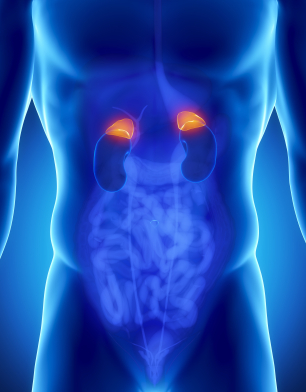Pheochromocytoma is an adrenal gland tumor comprised of chromaffin cells that produce and release excess epinephrine and norepinephrine, which are hormones that effect heart rate, metabolism, and blood pressure. Pheochromocytomas are generally benign and can appear at any age; however, they commonly occur during middle age.

If left untreated or unrecognized, this tumor can be life threatening. Researchers have yet to discover the underlying cause of pheochromocytoma. However, certain disorders such as Multiple Endocrine Neoplasia type II (MEN II), Von Hippel Lindau disease, Neurofibromatosis 1, and Familial Paraganglioma are associated with pheochromocytoma.
Isolated, paroxysmal episodes of hypertension occur in fewer than half of individuals with pheochromocytoma. Episodes of hypertension can occur at unpredictable intervals and usually last 15-20 minutes. During these episodes, the patient experiences hypertension, tachycardia, and fever; however, the patient’s vital signs can be normal at other times. As the tumor grows, episodes increase in frequency, length, and severity. Additional symptoms include abdominal pain, chest pain, irritability, pallor, and weight loss.
However, two thirds of patients experience chronic sustained hypertension. Whether sustained or episodic, the patient’s hypertension is associated with an increased risk of myocardial ischemia, heart failure, renal injury, and cerebrovascular accidents. Sudden cardiac death may occur secondary to catecholamaine-induced myocardial irritability and ventricular arrhythmias.
Diagnosis of pheochromocytoma is based on elevated levels of free catecholamines and metabolites, such as vanillymandelic acid and metanephrines, in the patient’s urine. The following additional tests can be used to diagnose pheochromocytoma: abdominal CT scan, adrenal biopsy, catecholamines blood test, glucose blood test, metanephrine blood test, MIBG scintiscan, and MRI of the abdomen.
The current treatment for pheochromocytoma is surgery to excise the tumor. It is essential to stabilize the patient’s blood pressure and pulse with adrenergic blocking medication prior to surgery. When the tumor cannot be removed, medication is required to manage it. The majority of patients have benign tumors that are excisable; however, 10% of tumors recur and 25% of patients still have high blood pressure after surgery.
A medical malpractice lawsuit may arise when a patient presents with typical signs and symptoms of pheochromocytoma but the doctor fails to make the diagnosis thereby causing bodily injury, disability or death to the patient usually as a result of uncontrolled hypertension.
